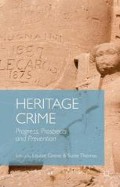Abstract
The threat to what is now known as archaeological heritage may even have started in pre-His panic times with looting and kidnapping of huacas (Andean sacred objects and places) by groups wishing to obtain them due to their inherent value (material), or (re)take the spiritual forces associated with the objects and even the archaeological sites. An example of this can be seen in the practices of appropriation of huacas developed by the Incas, both material and ideological, and even involving destruction (Topic et al., 2002, p. 311). With the arrival of the Spanish in the Andes, huacas were treated as if they were mines, even providing taxes to the Spanish crown. It is interesting to note that at that time this was a legal practice (Zevallos, 1994; Mujica, 2000, p. 220). Another activity that deeply affected archaeological sites and objects during the Viceroyalty of Peru (seventeenth to nineteenth centuries) was the destruction of huacas and objects associated with idolatry extirpators (Shady, 2008, p. 7; Gerdau-Radonic and Herrera, 2010). Although autonomy was achieved after the total expulsion of the Spanish following the Battle of Ayacucho in 1824, which arguably should have led to greater acknowledgement and ownership of the pre-Hispanic past, looting continued to occur in many parts of the nascent Peruvian republic.
Access this chapter
Tax calculation will be finalised at checkout
Purchases are for personal use only
Preview
Unable to display preview. Download preview PDF.
References
Bell, M. (2004) ‘Archaeology and Green Issues’. Inj. Bintliff, (ed.),4 Companion to Archaeology. CM alden: Blackwell Publishing Ltd.), pp. 509–531.
Byrnes, E. (2010) ‘Forestry and Archaeology in Ireland: Current Practice and Future Trends’. In S. Trow, V. Holyoak and E. Byrnes (eds) Heritage Management of Farmed ana Forested Landscapes in Europe. EAC occasional paper no. 4, pp. 147–156.
FAO (2010) ‘Global Forest Resources Assessment 2010’. Forestry Paper 163. Main report (Rome: Food and Agriculture Organization of the United Nations).
Gren, L. and Norman, P. (2010) ‘The Impoverishment of Heritage in the European Landscape — with some Swedish Examples’. In S. Trow, V. Holyoak and E. Byrnes (eds) Heritage Management of Farmed and Forested Landscapes in Europe. EAC occasional paper no. 4 (Brussels: Europae Archaeologia Consilium), pp. 169–176.
Hamberger, J., Irlinger, W. and Suhr, G. (2010) ‘Archaeology and Forestry in Bavaria (Germany): Cunent Practice and Future Trends’. In S. Trow, V. Holyoak and E. Byrnes (eds) Heritage Management of Farmed and Forested Landscapes in Europe. EAC occasional paper no. 4 (Brussels: Europae Archaeologia Consilium), pp. 157–162.
Holmblad, P. (2010) ‘Coastal Communities on the Move. House and Polity Interaction in Southern Ostrobotnia 1500 BC — AD 1’. Archaeology and Environment 26. Umeâ.
Lehtonen, K. (2008) Närpió, Pórtom-Granliden, arkeologisen kohteen tarkastus. Unpublished report. The Archives of the National Board of Antiquities. Helsinki.
Miettinen, M. (2013) Metsäasiaa. [Email]. Message to Laulumaa, 30 June 2013.
Mókkónen, T. (2011) Studies on Stone Age Housepits in Fennoskandia. Changes in Ground plan, site Location and Degree of Sedentism, Thesis, University of Helsinki.
Muckle, R. J. (2006) Introducing Archaeology (Peterborough, Ontario: Broadview Press).
Neustupny, Z. (2010) ‘Cover is no Shelter: Archaeology and Forestry in Czech Republic’. In S. Trow, V. Holyoak and E. Byrnes (eds) Heritage Management of Farmed and Forested Landscapes in Europe. EAC occasional paper no. 4 (Brussels: Europae Archaeologia Consilium), pp. 69–74.
Riksantikvarieämbetet (2001) Fórsók med markberedning inom omràden med fossil âkermark i Västra Gótalands, fónkópings, Kronobergs och Uppsala län — ett pilotprojekt (Stockholm: Riksantikvarieämbetet).
Soininen, O. (2001) ‘Metsien sertifiointi ja muinaisjäännókset’. Pirkanmaan alta: arkeologisia tutkimuksia, 2, 64–69.
Author information
Authors and Affiliations
Editor information
Editors and Affiliations
Copyright information
© 2014 Henry Tantaleân
About this chapter
Cite this chapter
Tantaleán, H. (2014). Archaeological Heritage in Peru: Definitions, Perceptions and Imperceptions. In: Grove, L., Thomas, S. (eds) Heritage Crime. Palgrave Macmillan, London. https://doi.org/10.1057/9781137357519_3
Download citation
DOI: https://doi.org/10.1057/9781137357519_3
Publisher Name: Palgrave Macmillan, London
Print ISBN: 978-1-349-47078-5
Online ISBN: 978-1-137-35751-9
eBook Packages: Palgrave Social Sciences CollectionSocial Sciences (R0)

